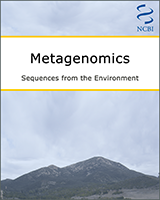NCBI Bookshelf. A service of the National Library of Medicine, National Institutes of Health.
Metagenomics: Sequences from the Environment [Internet]. Bethesda (MD): National Center for Biotechnology Information (US); 2006.
Anaerobic oxidation of methane (AOM) is estimated to consume a vast quantity of methane annually, however, the biology of this process is not well understood. It is suggested that methane is converted by methanotrophic Archaea to carbon dioxide and reduced by-products. Methane-oxidizing Archaea were isolated from deep-sea methane seeps for genomic analysis in order to test the “reverse-methanogenesis” hypothesis. Genes associated with methanogenesis were identified within an Archaeal group lending to a greater biological understanding of the process of methane oxidation in anoxic marine habitats.
Data
| WGS study | No WGS sequences available | |
| Contigs | Fosmid sequences | AY714814-AY714873 |
| Scaffolds | No scaffolds available | |
| Trace data | No available trace data | |
| 16S ribosomal RNA | No 16S rRNA data available |
4.6 Mbp of DNA sequence was generated from the fosmid library from 7104 reads (averaging 700 bp per read). 191 fosmids encompassing 7.4 Mbp were selected for subcloning and. Archaeal clones were chosen in order to maximize large-insert coverage dept of anaerobic methane-oxidizing Archaea genomes.
Isolation Source
Samples were obtained from a 6 to 9-cm deep sea sediment pushcore interval (PC45) isolated from the Eel River Basin off the Mendocino California coastline (dive T201, LAT: 40,785 LON: -124,596 at a depth of 520 m).
Genome Assembly
A group of anaerobic methane-oxidizing Archaea ANME-1 dominated the purified cell population. Analysis of gene content showed that these organisms harbor methanogenesis-associated genes, which allowed the fosmids to be divided into two bins, ANME-1 and ANME-2. Assembly of binned fosmids generated 13 unique scaffolds for ANME-1 and one scaffold for ANME-2, with no cross assembly between bins. Genes that were involved in reverse-methanogenesis were found associated mostly with one group of bacteria, ANME-1 (anaerobic methane-oxidizing Archaea), although some were found in ANME-2.
References
- Hallam SJ, Putnam N, Preston CM, Detter JC, Rokhsar D, Richardson PM, DeLong EF. Reverse methanogenesis: testing the hypothesis with environmental genomics. Science. 2004 Sep 3;305(5689):1457-1462. [PubMed: 15353801]
- Additional data are available from the AOM Microbial Community homepage at the Joint Genome Institute.
- PubMedLinks to PubMed
- Methane-Oxidizing Archaea - MetagenomicsMethane-Oxidizing Archaea - Metagenomics
- SIN3-HDAC complex-associated factor isoform 2 [Mus musculus]SIN3-HDAC complex-associated factor isoform 2 [Mus musculus]gi|2288874263|ref|NP_001398194.1|Protein
- PRJNA511578 (9)SRA
Your browsing activity is empty.
Activity recording is turned off.
See more...
